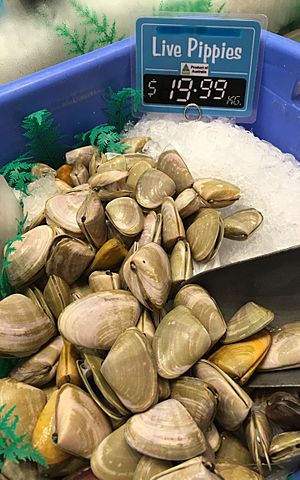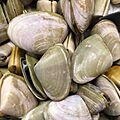Plebidonax deltoides facts for kids
Quick facts for kids Plebidonax deltoides |
|
|---|---|
 |
|
| Scientific classification | |
| Kingdom: | |
| Phylum: | |
| Class: | |
| Order: |
Veneroida
|
| Superfamily: |
Tellinoidea
|
| Family: |
Donacidae or Psammobiidae
|
| Genus: |
Plebidonax
|
| Species: |
P. deltoides
|
| Binomial name | |
| Plebidonax deltoides Lamarck, 1818
|
|
| Synonyms | |
|
Donax deltoides |
|
The pipi (also called pippi) is a small, edible clam that lives in saltwater. It's a type of bivalve mollusc, which means it has two shells hinged together, like an oyster or mussel. Its scientific name is Plebidonax deltoides or Donax deltoides. This amazing creature is found only in Australia.
In eastern Australia, it's widely known as the pipi. But in South Australia, people call it the Coorong cockle or Goolwa cockle because it's very common in those areas. The Ngarrindjeri people, who are the traditional owners of the land, call it kuti. In south-eastern Queensland, it's often known as eugarie or yugari. It's important not to confuse the Australian pipi with a different bivalve in New Zealand that also goes by the name "pipi."
Contents
Pipi Life Cycle and Habitat
The pipi is a popular seafood found along Australia's coast. You can find them from the Eyre Peninsula to Kingston SE in South Australia, and all the way from Tasmania to Fraser Island in Queensland. The largest group of pipis in Australia lives on the Younghusband Peninsula (Coorong Beach) in South Australia. In fact, their shells have helped form the sand dunes there over thousands of years!
Pipis live on beaches where the waves are strong. Young pipis live in the intertidal zone, which is the area between high and low tide. Adult pipis live a bit deeper in the subtidal zone. They use a strong foot to dig into the sand, usually about 100 mm deep. To eat, they filter tiny plants called phytoplankton from the water.
Pipis usually become adults around one year old and can live for four to five years, growing up to 80 mm long. They reproduce by releasing their eggs and sperm into the water, mostly in spring. The baby pipis, called larvae, float around as plankton for four to eight weeks. They can travel long distances with the ocean currents. Pipis need strong waves to survive because the surf helps bring them food and adds oxygen to the water. If the weather is too calm for too long, pipis can start to die off.
Pipi's Scientific Name and Family
The pipi was first described in 1818 by a scientist named Jean-Baptiste Lamarck. He based his description on specimens found on Kangaroo Island.
Over the years, scientists have debated which family the pipi belongs to. Some classify it in the Donacidae family, while others place it in the related Psammobiidae family. In 1930, another scientist, Tom Iredale, suggested a new group called Plebidonax for the pipi. While some scientists use Plebidonax, many still use Donax. If it's classified as Plebidonax, it's the only member of that group! A study in 2017 looked at the pipi's genes and found that it seemed to fit better with the Psammobiidae family.
Pipis in South Australia
The Ngarrindjeri people have eaten pipis, which they call kuti, for a very long time. They were an important source of food, often cooked on hot coals or in mud ovens right on the beach. You can still see ancient piles of shells, called shell middens, around the Coorong and Goolwa beaches. These middens show how much the Ngarrindjeri people relied on pipis.
After European settlers arrived, the Ngarrindjeri people were moved from their traditional lands and couldn't easily get to their fishing spots. A famous Ngarrindjeri inventor, David Unaipon, even asked for a fishing license in 1913, but it was not given to him.
For many years, Europeans mainly used pipis as bait for fishing. But in the 1990s, Italian immigrants introduced pipis (which they call vongole) to restaurants. This made pipis more popular for eating, and their price went up. In 2004, rules were made for catching pipis for people to eat. Today, cheaper imported clams are often used as bait instead of pipis.
The Cockle Train, Australia's oldest steel-tracked railway, was built in 1854. It got its name because colonists used it a lot to collect pipis from the beaches near the mouth of the Murray River. Today, it's a popular tourist attraction.
Managing Pipi Fishing: Quotas and Rules
In 2008, because many people wanted pipis and fewer were being caught, a limit was put on how many could be caught by commercial fishers. This limit, called a quota, was 600 tonnes. Commercial fishing was only allowed in certain areas. However, some fishing companies felt the quotas were unfair, and the South Australian Legislative Council changed the rules.
The 2009 fishing season had to be closed early because too many small, young pipis were being caught. This showed that the pipi population was in trouble. A new group, The Goolwa Pipi Harvesters Association, was formed to help manage the pipi industry in a way that would keep it healthy for the future. The quota for future seasons was set much lower, at 600 tonnes per year.
In 2010, the government lowered the commercial quota even more, to 300 tonnes. They also made a new rule for people fishing for fun: you could only catch 300 pipis per person per day. Fisheries officials checked catches and fined people who caught too many or pipis that were too small.
By 2011, the pipi population started to recover a bit, so the commercial quota was slightly increased to 330 tonnes. Recreational fishers were allowed to collect pipis in more areas. Commercial fishers without a quota could still catch a small amount (10 kg per day) for their own use as bait, but they couldn't sell them. The minimum size limit for pipis was kept the same but would be checked every year. The Goolwa cockle was officially renamed "pipi" by the government department.
For the 2012 season, the commercial quota went up again to 400 tonnes. The government also planned to create a special protected area, called a marine sanctuary, to help protect pipi stocks. Commercial fishers discussed asking for help or for the sanctuary to be moved so it wouldn't affect their fishing too much.
2020: Kuti Co. Partnership
In 2020, the popularity of pipis had grown a lot. A new partnership was formed between an Indigenous business called Kuti Co. and the Goolwa Pipi Co. This partnership meant that many Ngarrindjeri workers would be employed in the pipi industry. This helps bring cultural pride and understanding of their heritage to the community.
Pipis in Victoria
Pipis used to be caught in "massive quantities" from beaches in South Gippsland, Victoria. But by the 1970s, there weren't as many pipis, so only people fishing for fun could catch them. The limit for recreational fishers was reduced to two litres per person per day in 2009. If you're fishing for pipis in Victoria, you need a fishing license. Also, you can only dig for pipis using your hands or feet – no tools allowed!
Pipis in New South Wales
New South Wales has had a small commercial pipi fishery since the 1950s. However, the amount of pipis caught went down after 1998 because of contamination from harmful algae. In New South Wales, commercial fishers collect pipis by hand, mostly from Stockton Beach.
To make sure there are enough pipis for everyone and to stop illegal selling, people fishing for fun are allowed to catch up to 50 pipis per day. By law, these pipis can only be used as bait because some people got sick from eating them due to toxins. In 1999, it was estimated that people fishing for fun caught about 45 tonnes of pipis each year, mostly for eating.
In 2011, because there were worries that the pipi population might crash, the government put a partial closure on the fishing season and set a minimum size limit of 40 mm for commercial catches. The status of the pipi fishery in New South Wales is currently listed as "Uncertain."
Images for kids




